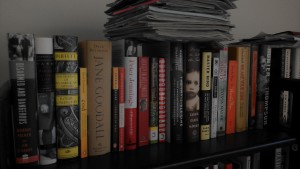 This week at Retraction Watch witnessed the fall of a “golden boy” and a “NASA Patriot Boy.” Here’s what was happening elsewhere:
This week at Retraction Watch witnessed the fall of a “golden boy” and a “NASA Patriot Boy.” Here’s what was happening elsewhere:
- Dong-Pyou Han, the former Iowa State University vaccine researcher who confessed to faking his results, has signed a plea bargain with Federal prosecutors.
- Oh good, I.P. Freely, Hugh Jazz, and Amanda Huginkiss have published a paper.
- Huge science publishing news: Nature Publishing Group’s parent company and Springer are merging.
- A retraction-related cartoon, courtesy of The New Yorker.
- That cancer-“luck” study “seems to be the product of lax peer review and pressure to over-interpret data to boost public interest,” writes Aaron Meyer. And Jennifer Couzin-Frankel reflects on her coverage of the paper in Science.
- “My professor is rigging data and plagiarizing. What can I do?”
- “So what’s the best system of post-pub review?” asks Paul Knoepfler in a review of ongoing questions about stem cell research.
- Deans from across Taiwan were scheduled to meet this week to tackle plagiarism, the Taipei Times reported.
- Tom Spears, of the Ottawa Citizen, covers “the latest science scam: Peer-reviewing your own paper.”
- Does science have a creativity crisis? Roberta Ness thinks so.
- Are we witnessing a U.S. funding turnaround? R01 success rates grew slightly last year.
- fMRI results may be significantly skewed by head movement in scanners, according to a new study.
- Most Americans would share their health data for research purposes, says a new poll.
- Scientists, get to know your university’s public information officer, urges The Scientist.
- Most education journal editors agree “that re-use of long, verbatim passages or tables, figures and images from an author’s previously published work without appropriate citation is unethical, and most editors viewed less egregious self-borrowing as wrong also. However, numerous editors expressed unease with the general concept of self-plagiarism, and several of them noted contextual factors that can make limited self-plagiarism acceptable.”
- “How Do You Know It Is True?” ask three orthopedic surgeons about the scientific literature.
- A biochemist has found that “scores given to grant applications by external reviewers don’t correlate with what actually gets funded” by one UK funding agency.
- “Whatever is Hottest is Almost Certainly Overhyped:” Brian Reid offers five universal truths about a popular health care conference.
- “Luc Tuymans, Flanders’ greatest living painter, is being accused of breach of intellectual property rights over a 2011 work that he claims is a parody.”
- Johnson & Johnson, working with Yale University, will make its clinical data available to outside researchers, the drug giant announced this week.
- The American Association of University Professors’ history of fighting for the rights of faculty turns 100 this year.
- “Disciplines That Expect ‘Brilliance’ Tend to Punish Women, Study Finds.”
- Patients with multiple sclerosis are questioning the credentials of a man in Canada involved in stem cell therapy.
- “What is ironic science?” asks John Horgan.
NPG + Springer Science + Business Media? I am really worried with this news. This is going to be a massive game changer, potentially placing (if numbers here are accurate*) this new group as the second largest STM publisher on the planet. We have, scientists, the enormous responsibility of pro-activey analyzing the already published literature of these publishers’ journals. Recent events, at least in the plant sciences, are revealing how many flaws exist in the Nature nest of journals as well as in Springer S&BM’s journal and book collection. Post-publication peer review is going to require a concerted effort to hold these publishers accountable for what they have published but for which they are still reaping massive profits.
* http://journalseek.net/publishers.htm
That said, I was browsing through some Springer biotech journal titles today, when I noticed something rather curious: the migration of one more Springer journal to DeGruyter:
http://www.springer.com/life+sciences/cell+biology/journal/11658
It would be interesting to know the background behind such migrations, e.g., unsatisfied editors or society, lower costs, different benefits? Any insight welcome because, at the end of the day, scientists’ work are being floated around from publishing house to publishing house. In such a volatile publishing environment, we need to understand how our rights as authors change, including copyrights.
Personally, for me it is important because I have noticed, increasing considerably in 2014, a very fierce resistance by Springer plant science editors to address issues, to skirt them, and to, most importantly, continue to refuse the importance of post-publication peer review. IN almost 100% of cases that I am aware of that were reported to Springer about problematic papers were either ignored, or met with minimalistic effort to correct. Once the wider community understands that this is equal to a gross negligence of corporate responsibility, this NPG + Springer merger will come under even greater scrutiny, as wil their published literature.
There is simply no way for publishers to escape post-publication peer review, because it relies on a deeper interpretation of already published facts.
Dear CR,
take a look at this post in portuguese about the article you talked about before (https://pubpeer.com/publications/DAE3F446AF7669736A28A4DA9EAD4E):
http://cienciapublicada.blogspot.de/2015/01/introducao-ciencia-publicada-analise-de.html
The secret of “How do you know if it is true ?” (J Bone and Joint Surgery Jan 2015) will remain hidden from those who can’t afford $35 to gain access.
Breaking news re “Luc Tuymans, Flanders’ greatest living painter, … …
The artist has been found guilty.
“The court ordered Tuymans to refrain from making further copies of the work at the risk of being fined €500,000 per copy, the sum for which Tuymans sold the painting to an American couple in 2012.
He says he will appeal
From http://www.flanderstoday.eu/current-affairs/artist-luc-tuymans-found-guilty-plagiarism